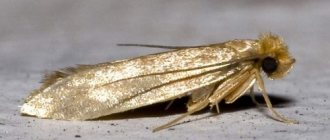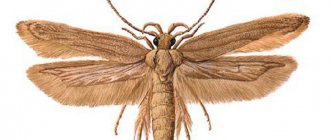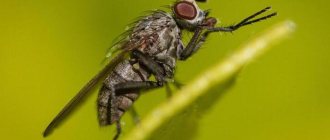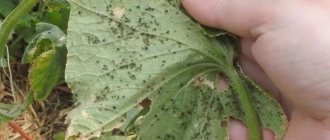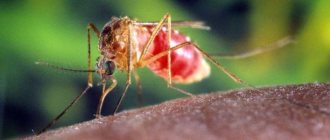Almost every housewife is familiar with the problem of certain types of moths, popularly called food moths, appearing in the kitchen. The wide prevalence of insects is due to their food indiscriminateness; nuts, dried fruits, groceries, cereals, and other bulk goods can serve as a food source for them.
If small larvae are found in contaminated cereals or other products, you should immediately begin the process of eliminating the problem.
It should be noted that the fight against food moths is a very costly and troublesome undertaking, because most insecticides widely used to eliminate other types of insects are practically irrelevant in this situation.
How to get rid of food moths in the kitchen and prevent the appearance of uninvited guests in the future - we’ll talk about this later.
What does the pest eat and how does it penetrate food?
Having gotten rid of food moths, it is important to prevent re-infestation of the kitchen
- Before putting food into containers, check each one for food moth infestation.
It is better to purchase groceries in factory packaging rather than prepackaged in a store - If possible, avoid long-term storage of groceries.
If you buy food for your family, then for no more than a week, the risk of infection with food moths will be significantly reduced. It is better to buy more product than to throw away old supplies due to food moth infestation - Use pleasant and harmless aromatic products.
For prevention, a very small amount will be required. You can make your own home remedy for moths - Store food in airtight containers.
Even if you accidentally miss a larva, it will not be able to get out of the container and infect neighboring ones. Migratory adults will not have the opportunity to lay eggs. Hermetically sealed products are not at risk of contamination by food moths - Monitor the condition of windows, doors and ventilation openings. An ordinary mosquito net will protect the house not only from the accidental penetration of moths, but also from many other household pests.
An adult eats practically little, but when it arrives in the caterpillar stage, it is quite voracious and capable of causing significant harm.
Most often, larvae can be found in dry foods, cereals, pasta, peas, beans, nuts and dried fruits. In addition to feeding on your supplies, caterpillars also leave waste products behind, making the food they were found in unsuitable for food. The larvae leave behind cobwebs, scales, feces and other unpleasant things.
Food moths can spoil seeds for sowing by simply gnawing out the embryo. It can also grow in candies, seasonings, tea and crackers.
A remarkable fact. If a moth starts in a bag of grain, it can envelop a layer up to 10 centimeters deep with its web. In this case, the grains lose their nutritional value and are completely unsuitable for food.
Therefore, answering the question of which products contain food moths, it is only possible to highlight a large list, which you may consider incomplete. Since moths will start or not depends on the conditions under which you store your supplies.
Within 60 days, the larvae manage to change the skin 3-4 times, which remains in grocery products. Plus, the pest actively feeds, so feces are present in the cereals.
Eating foods that contain moths is prohibited and even dangerous to health. The consequences can be depressing:
- intoxication;
- decreased protective functions of the body;
- disruption of the gastrointestinal tract;
- allergic manifestations.
Adults do not need food. The greatest damage is caused by the larvae of cereal pests. Caterpillars are very voracious; they leave their feces, scales, and other waste products in packages and bags. Depending on the type of pest, the following food products are affected:
- pasta;
- processed cereals;
- grain reserves intended for planting;
- nuts;
- legumes;
- bakery products;
- cookie;
- candies and chocolate;
- flour;
- dried fruits;
- tea;
- seasonings
If grain is stored in large bags, then the larvae wrap their web in a layer up to 10 cm thick. Such grains become unsuitable for food. It is difficult to protect supplies even when stored in thick plastic bags. Caterpillars chew through such materials and penetrate inside.
Food moths are extremely difficult to get rid of. To prevent the spread of pests, the following rules must be observed:
- purchase groceries only in stores that comply with storage conditions;
- carefully inspect the packaging, do not take cereals in bags with holes or slits;
- check the contents of the packages for the presence of larvae immediately after opening;
- keep purchased cereals and pasta in the freezer for several hours or bake in the microwave;
- store pasta, cereals, sugar in glass or plastic containers with tight lids;
- keep herbs or cotton swabs soaked in fragrant essential oils in your kitchen cabinets.
Why does it appear and what does it eat?
What do food moths eat? The diet of these picky insects is unusually wide.
As a source of food for the larvae (adults do not need food, moreover, they have an undeveloped digestive system), choose cereals, nuts, dried fruits, flour, sugar, crackers, and cookies. In a word, even in a kitchen with the most modest supply of food, these insects will find a sufficient amount of food.
The most important question for many housewives is the following: how food moths appear.
Insects do not have the ability to move over long distances, that is, they cannot move independently between dwellings.
Infection of groceries most often occurs when purchasing products containing larvae or clutches of eggs, from which pests quickly emerge at sufficient temperature and humidity.
Signs of kitchen moth infestation
Having figured out how moths appear in the kitchen, we move on to the next stage - getting rid of them
It is important to understand that the sooner you begin the process of “treating” the kitchen from food moths, the less effort you will have to put in
If you are not sure whether you have moths in your kitchen, use our life hack. Turn on a small flashlight in the kitchen at night and wait five to ten minutes. Adult butterflies always flock to the light.
Many companies now offer services for quickly removing “unwanted guests” from your kitchen. However, we believe that it is not worth going there when it comes to food moths.
Firstly, they often use aggressive chemicals that are undesirable to come into contact with products and work surfaces. Secondly, their services are quite expensive. And most importantly, it’s not difficult to get rid of moths on your own; you just need to be diligent and carefully follow our step-by-step recommendations.
First of all, it is necessary to conduct a thorough inspection of the premises. First, inspect your kitchen cabinets and their contents. Check all containers with cereals, flour, spices and other groceries. You should be especially careful if you store food in plastic bags.
By the way, hungry larvae can easily chew through bags and even plastic containers, so if the package is closed, this does not mean that it is not infected.
Check the tops of cabinets, baseboards, cornices, and chandeliers. Adults may be hiding there and must also be destroyed.
First, throw away those foods that are obviously contaminated. If you are not sure about something, remember that it is better to be on the safe side than to have to deal with multiplied moths again later. Therefore, do not skimp on cereals that seem suspicious to you. Throw away anything that causes even the slightest suspicion of contamination.
In this way, treat all surfaces where larvae may be located.
This could be the familiar adhesive tape that is used in the summer as a fly trap. A more modern option is a pheromone trap. It emits a pleasant aroma for moths, which attracts them. Then you just need to throw away such a trap. The trap will neutralize the males, and the females will not be able to reproduce and will soon die out - remember, the life cycle of a moth is only one week.
Just in case, vacuum the ceiling and cornices - most females are very slow and this way you can significantly reduce their number.
Reasons for the spread of pests
Many housewives do not understand why food moths appear in a house or apartment. After all, adult pests and larvae travel minimal distances. Therefore, clothes and food moths enter the house along with nutritious foods, clothes and household items.
Most often, the gray butterfly enters the house from the market or store along with infected products. Since in many stores products are packaged in warehouses, determining the presence of insects is problematic. It appears in cereals and flour due to improper storage or non-compliance with temperature conditions. Because of this, the intervals between food moth development cycles are reduced.
In such conditions, it is problematic to clean food from food moths. If you block the flow of air mass or turn off the ventilation system, you can only partially get rid of it. To get rid of moth larvae, drastic measures will be required. Infected cereals must be subjected to heat treatment. Anti-mosquito nets are installed on window and door openings, through which entry routes are blocked.
When identifying where food moths come from in the house, you need to pay attention to old food supplies. After all, food moths start in those products that are stored for a long time.
Precautionary measures
It is impossible to provide guaranteed protection against moths entering an apartment, but there are certain precautions. It’s easier to follow simple rules than to rack your brains over how to remove food moths
Try not to make large supplies of provisions at home unless necessary. It is better to buy fresh flour or cereal than to store a huge bag in the house. Often people are driven by the desire to save money by purchasing a product at a wholesale price. It’s better to overpay a little than to throw away a twenty-kilogram bag of flour infested with flour moths. Buy products from trusted manufacturers. The most dubious products are those sold at a reduced price. Perhaps the store wants to quickly get rid of insect-infested products. Carefully examine cereals, dried fruits, and cocoa through transparent packaging. If you find something suspicious in the products (pieces of cobwebs, larvae, lumps), set them aside. Take fluttering moths as a signal of distress and don't hesitate to clean and inspect your kitchen cabinets. There are times when moths start in a handful of cereals or flour spilled behind the kitchen cabinet. Don't ignore storage rooms and balconies. Check all places where food supplies are or were once located. Check not only dry foods, but also vegetables
Pay special attention to potatoes and cabbage. Certain species of moth prefer these products.
Who is a house moth?
Before you start fighting a flying pest, you need to understand what a house moth is. This is an insect that appears most often in bulk products: seasonings, rice, buckwheat, flour and others. There are several types of pests:
- flour moth;
- cocoa moth;
- southern barn moth.
Such insects can appear even in the cleanest cabinets. They come to the kitchen along with larvae straight from the stores. A week after purchase, pupation occurs and moths appear. They live well in packs, damaging cereal grains. Sometimes they are even capable of deforming unsealed paper packaging (flour, coffee, cocoa, corn grits)
Please note that moths can also enter the house with dried fruits, which many housewives stock up on for the winter.
PHOTO: pinterest.ruDestroy both moths and larvae at the same time
Moth repellents in household chemical stores: surefire ways to get rid of the pest forever
Chemical poisonous agents are the most effective in the fight against moths; they will help you get rid of the pest forever at home. You can buy them in specialized departments of stores
It is important to remember: drugs should not come into contact with food.
They should be used strictly in accordance with the instructions.
It is also necessary to pay attention to what type of moth they are intended for: products for clothes moths may not have an effect on food
Choosing an aerosol
Insecticides in spray cans are popular because they can kill pests in a short time. The disadvantages include harm to the body: an aerosol cloud of microparticles causes irritation of the respiratory tract. Before use, you will have to remove all products from the kitchen.
| Name | Advantages | Flaws |
| Raptor "Protection from moths" | Kills insects at any stage of the life cycle | Acrid smell |
| Armol | High efficiency compared to similar products. Prolonged action (up to 6 months). Smells like lavender | Causes allergies in children |
| Clean house | The presence of a spray tube allows you to inject the product in a targeted manner. High efficiency | Toxic, when working you must use a respirator and gloves |
| Combat Super Spray | Destroys moths and larvae in a short time. Safe for animals. Equipped with a flexible nozzle for hard-to-reach areas | May cause allergies |
Repellents: which one should you choose?
The main advantage of repellents is their ability to completely eradicate a population. They contain substances that repel insects and block the ability of moths to lay eggs.
Repellents are made in the form of tablets (briquettes) and plates. The first ones are placed inside and on top of kitchen cabinets.
The plates are usually equipped with a special hook for hanging.
Important! Contact with products must not be allowed.
| Name | Advantages | Flaws |
| Armol, plates | Contains permethrin, which paralyzes the butterfly's breathing. Acts on larvae. Contains lavender oil | Short validity period |
| Greenfield, tablets | Destroys adults and caterpillars | Need to change every 3 months |
| Kartas, tablets with various flavors | Contains natural oils. Has an antiseptic effect | Repels but does not destroy moths |
| Antimol effect, tablets “Cinderella”, “Selena” | Has a prolonged action | Does not kill insects |
Sections and sachets
Food moth sections are gaining popularity as one of the safest and most productive ways to get rid of insects and their larvae.
The sections are attached to the cabinet wall or hung using a special hook. They are valid for up to six months. Like repellents, they prevent the reproduction of insects.
They are available in various scents that repel moths (lavender, tangerine), but may not be scented.
| Name | Advantages | Flaws |
| Globol | Destroys moths, eggs and larvae. Equipped with an expiration date indicator | Not identified |
| Raptor | Effective against moth at all stages of development | May cause allergies |
| Mosquitall | Effective on adults. Safe for people. Can be used as a prophylactic | Larvae are not susceptible to the drug |
Bags act similarly to sections against food moths. Inside them there is impregnated granules. The active substance can be both chemical insecticides and natural essential oils (lavender, orange). The advantages and disadvantages are the same as those of the sections. For the complete destruction of insects, the bags are ineffective and have repellent properties.
The most popular:
- Aerokson with floral aroma;
- Greenfield with lavender oil (positioned as an environmentally friendly product);
- Selena-taiga with natural herbs and oils.
What is the secret of moth traps
The traps consist of a body with a sticky liner and a pheromone dispenser. They do not contain toxic substances and are safe for people and animals. Can be placed near food. The action of the trap is based on attracting an insect with a special substance and mechanically holding it on a sticky surface. The adhesive liner must be changed from time to time.
There are glueless traps consisting of a body and a dispenser. Attracted by the smell, the moth falls into a special compartment.
The most effective and popular is the German AEROXON trap. Argus and Delta-250 have proven themselves well.
Why is an insect dangerous?
The places where moths live are not only the kitchens of residential buildings, but also warehouses, where they eat all poorly sealed cereals. An unscrupulous manufacturer, having discovered insects in a product, knows that selling it even after careful selection is impossible, so he makes a significant markdown. By purchasing goods in stores at a reduced price or on promotions, the consumer risks bringing unfortunate parasites into the house. They do not pose any direct danger to human health.
However, irreparable damage is caused to food supplies, and few people will be pleased to find the corpse of an insect or its larva in a cup of tea or a vase of jam. In dry foods, cereals, dried fruits, the process of moth degeneration occurs, that is, it not only eats them, but lays eggs, which then turn into larvae, which are considered the main eaters of human food.
This entire life process takes place in the kitchen in food products, from which food is then prepared. But they are no longer suitable for consumption, as they are contaminated with live and dead moth larvae, the remains of adult individuals, and feces. After damage to insects, no one eats food anymore.
It is quite difficult to kill an insect with cotton, since it not only eats quickly and randomly, but also moves through the air, usually under the ceiling. Pests enter the active phase at night, during a safer and freer period for movement. At this time she eats everything. The food moth lives for no more than three weeks, but it is not advisable to hope for its disappearance and do nothing, because during this time it will leave a countless legacy in the kitchen as a gift.
Types and characteristics of the pest
As soon as moths have infested rice, you should expect the emergence of adults and new clutches of eggs. To destroy all pests, an integrated approach will be required, including the following steps:
- Establishment of habitat.
- Cleaning main surfaces and kitchen units.
- Removing all cereals and products that have been infected.
- Treatment of infected grains.
Knowing how to determine the presence of pests in the house, it is easier to choose effective control methods. Main features:
- An adult pest can be found on the ceiling and walls.
- The presence of cocoons, peculiar seals. They are found in products.
- The presence of worms and pupae in the kitchen set.
Pest control in the kitchen is necessary as soon as pupae, larvae or adults are discovered. Although the lifespan of an insect in the kitchen is 2–3 weeks, this time is enough to infect all rooms. Some moth species have a lifespan of up to 4 weeks. This pest multiplies and spoils food all year round if it is not poisoned.
Before you fight parasites, you need to study where they come from. Main routes of penetration:
- Ventilation shafts and air ducts.
- Gaps between building materials in multi-storey and country houses.
- Infected cereals, food products, and dried fruits.
- Window openings that are not covered with mosquito netting.
Specialized websites and books contain many pictures and photos of food moth larvae and the main stages of development. A certain type of pest may appear in the house and living room:
- Barn. The main preference is nuts. For reproduction, the imago chooses secluded and dark places.
- Flour. Flour moths lay eggs in flour. Infected flour that is in the warehouse is thrown away because consuming it is hazardous to health.
- Potato. You can see how the potato food moth reproduces in your garden or garden. Although butterflies do not eat vegetables and plants, they cause a lot of harm. After all, they lay eggs, from which harmful larvae emerge.
- Grain. Not all people know how to fight it and what this species eats. The grain species is actively spreading in our country. And it is difficult to find out in advance in which cereals the worm will start. That's why people buy contaminated products.
- Ognevka. The harm to humans from this insect is quite great. Every beekeeper knows how to distinguish the moth. The main differences are studied before bees are started to be bred. After all, these pests penetrate inside and destroy the insulation and honeycombs.
The color of the imago is gray or gray-brown. If food moths are located in a horizontal position, then it is difficult to notice them even in open areas. These pests have wings that reach 7–8 mm in length. Only scientists who know where insects come from can distinguish a food pest from a clothing pest by its characteristics. Ordinary citizens cannot cope with this.
Moth eggs are small in size. Since not everyone knows what the eggs of a food parasite look like, it is difficult to immediately identify infected cereals or dried fruits. They are similar to semolina grains that have stuck together. Larvae emerge from food moth eggs after 7–10 days. It all depends on how suitable the conditions are for the parasite. The body length of food moth larvae is 14–15 mm. Worms differ from adults in that they prefer a hidden lifestyle. They move only short distances in order to get a portion of nutrients. To quickly determine their presence, you need to know exactly what the larvae look like. Their photographs are presented online. Under favorable conditions, the larvae quickly pupate and develop into adults.
Why are food moths dangerous?
It doesn’t matter where the moth came from in your kitchen, what matters is that it can seriously ruin the health of you and your household
- The waste products of any type of moth are toxic, so the source of infection must be eliminated as soon as possible.
- Eating foods contaminated with food moth eggs can cause symptoms of poisoning.
- Being close to moths and their feces can cause severe allergies.
- The waste products of this pest can cause damage to the immune system that is difficult to treat.
And, of course, butterflies fluttering around the lighting fixtures and larvae squirming in the cereals call into question the proper sanitary condition of the kitchen.
Harm from the presence of a food parasite
The degree of spread of larvae and adults depends on how correctly the methods of control are selected. The presence of moths and their larvae indoors contributes to significant costs, as they spoil food, cereals and some materials. These pests carry certain bacteria and contaminate cereals and fruits. Insect larvae cause certain harm:
- Allergic reactions. Due to the transfer of allergens and bacteria, the likelihood of allergies increases significantly. This is why food moths are dangerous for adults and children.
- Deterioration of health and loss of strength.
- Intoxication of the human body.
To prevent such unpleasant surprises from occurring, food moths must be gotten rid of. Therefore, all people should know what clothes and food moths look like.
How to get rid of food moths in food in the kitchen?
You can get rid of food moths in an apartment in several basic steps, which must be completed in order to avoid its further reproduction.
Examination
First of all, you should search the entire kitchen, every jar, plastic container and other storage areas. Found colonies with larvae should be thrown away immediately, but not in the trash, but in a container on the street. Do not spare those foods where moths have infested, because if there are a lot of larvae there, it will be impossible to eat them.
spring-cleaning
Cleaning helps both get rid of moths and simply make the kitchen cleaner
All cabinets, bedside tables and other places should be thoroughly cleaned, paying special attention to doors, internal cavities and even small joints where cocoons may remain unnoticed. Wipe with soapy water, thoroughly rubbing it into the surface.
After this, it is recommended to moisten the areas where the most pests were found with vinegar and leave to ventilate to eliminate the odor.
Be sure to use a vacuum cleaner to go over small joints, as well as along the ceiling. Containers and jars where moths have already appeared should also be thoroughly rinsed and dried, which will help prevent their further appearance.
Creating Traps
Of course, it is quite easy to kill a large individual, but this is not the most effective method. Therefore, you should think about creating several traps in places where they may appear. Flying adults, like other insects, respond well to duct tape suspended from the ceiling. You can also install sticky strips in cabinets where food is stored in jars and sealed packages.
There is also a separate type of trap that uses bait. It has a pyramidal shape with holes where moths crawl through and then get stuck on the sticky surface. Due to this, the number of adults decreases, as does the possibility of their reproduction.
Use of folk remedies
When wondering how to remove food moths, you should know its main weaknesses. What are food moths afraid of? Like any other insect with a keen sense of smell, it cannot tolerate strong and bright odors, which may seem ordinary and familiar to us. Therefore, folk remedies for food moths include such products as:
- Garlic: a couple of peeled cloves are recommended to be placed in the cupboard with cereals and other products;
- Laurel: several leaves can be hung in places where cereals and dried fruits are stored;
- Tobacco: the powder or leaves of this plant have a persistent odor that is not perceptible to humans, but at the same time perfectly repels pests;
- Citrus fruits: we are talking about both fresh peel and citrus extracts, for example, from orange or lemon;
- Oils: essential oils have a pleasant smell, but they also contain components that are harmful to pests;
- Herbs: these include mint, lavender, rosemary and others, which can be stored either fresh or dried in the food cabinet.
Store-bought pest control
In addition to home methods, you can use commercial insect repellents. They help both to eliminate living individuals and also have a very unpleasant odor, which repels and does not provide the opportunity for reproduction.
Among the most famous brands are Raid, Raptor, Armor and others. Also considered one of the most effective methods is an ultrasonic trap, which is absolutely safe for people and pets.
How to prevent the reappearance of food moths in an apartment?
You can forever forget about such a pest as food moths if you follow a few simple rules. To do this you should:
- Carefully check products purchased in a store, especially if cereals are stored in packaging or taken in bulk;
- Purchase goods only from a trusted manufacturer;
- Arrange ventilation and regular general cleaning in the kitchen;
- Block the ventilation hole using the finest mesh, thereby preventing penetration from the street;
- All bulk products should be stored in airtight glass and tightly closed jars;
- Store special bags of aromatic herbs in food cabinets;
- Do not leave cups of water and always wipe the kitchen sink dry;
- Maintain general cleanliness in the kitchen, get rid of crumbs and dirt in a timely manner;
- Check products for pests more often;
- Buy only what you need, without saving significant supplies for later;
- Store most foods in the refrigerator.
By following these simple rules, you can once and for all forget about the possibility of such an unpleasant parasite appearing and no longer think about how to get rid of food moths in the kitchen.
How to get rid of it using folk remedies
To effectively fight a food pest, you need to find out how the insect appears in the kitchen, what places it avoids, where it prefers to settle, what factors are irritating and destructive for it. For the purpose of control or prevention, you can use simple folk remedies, including plants and products with a specific smell that repels moths:
- Garlic. The phytoncides emitted by the spice are unpleasant to the insect. Peeled garlic cloves must be placed in all drawers and on all shelves in the kitchen cabinet. If you have a pantry in your house, then you should put garlic there too.
- Lavender. The smell of this flower also repels moths. The brooms of the dried plant can be hung or placed near food supplies. You can make decorative bags with lavender contents and decorate your kitchen with them.
- Spices. Cloves and bay leaves have a repellent effect.
- Herbs. It is recommended to place sprigs of wormwood and peppermint in the kitchen.
- Citruses. The smell of citrus fruits is a strong irritant for food moths. You can treat your kitchen furniture with orange or lemon essential oil, or put citrus peels on shelves and drawers.
It is easier to prevent any problem than to deal with it. This also applies to insect control. There are activities that you can do without worrying about moths spoiling your food. Preventive measures include:
- thoroughly checking for the presence of larvae and eggs of all purchased bulk products (flour, cereals, sugar, seeds, nuts), especially unpackaged ones;
- purchasing only high-quality and fresh products (do not chase promotions; a price reduction is a sure sign that the goods are stale and spoiled);
- replenishing food supplies only as they are depleted (do not keep large quantities of flour, sugar, and cereals at home);
- regularly cleaning and wiping the shelves and drawers of the kitchen cabinet;
- storage of bulk products in hermetically sealed containers, glass or metal;
- regular ventilation of the kitchen, wet cleaning;
- Immediate disposal of spoiled food;
- constant use in the kitchen of herbs, spices and essential oils that are pleasant to humans, but irritating to insects (lavender, bergamot, rosemary, citrus oils are suitable).
Some housewives use a simple and effective method of preventative treatment of store-bought nuts or cereals. The product is poured into a suitable container, placed in the microwave for half a minute, and kept at maximum power. During this time, neither nuts nor cereals will be baked, and the larvae, if any, will be destroyed.
If the housewife regularly evaluates the state of food supplies, is attentive to the purchase of food products, stores food correctly, maintains order in the kitchen, and applies preventive measures, then she will not have to deal with the issue of destroying food moths.
What is food moth and why is it dangerous?
The food moth is a small insect that looks very similar to its clothing counterpart
The flying individual is quite safe, since it practically does not feed on the foods that we eat, but there is one important and significant “but”: it actively lays eggs in cereals, cookies, tea and other goods. Housewives know how difficult it is to remove food moths and their larvae if they have been discovered at least once
After all, this insect cannot be stopped by simple cellophane packaging: it actively gnaws its way to the desired breeding sites, while spoiling everything it touches.
You should also carefully check all products that may be accessible to the pest, including sweets and dried fruits wrapped in paper. Cereals, even after sifting, are not suitable for food, since particles of dead larvae and their cocoons may remain there. In addition, like any insect, moths can spread various diseases and infections, which can affect the overall health of household members. Therefore, you need to fight food moths in the kitchen actively and quickly, preventing them from multiplying.
Where do moths come from in the kitchen?
The appearance of food moths in the kitchen is an unpleasant surprise for any housewife. After all, no one is safe from the sudden appearance of this creature in products, even those who keep their kitchen and apartment sterilely clean. Moths can easily fly in from the street through open windows or ventilation, and they can also be brought in with other products. Especially if you buy cereals, nuts and other goods by weight, and not in sealed packaging, which, however, does not always guarantee its absence.
Therefore, as soon as these flying creatures were noticed in the kitchen area, it is imperative to check all cans of cereals, powders and other bulk products. After all, having appeared in one place, the moth very quickly deposits its larvae in jars with other cereals, thanks to which, if it is not removed in time, you can say goodbye to the entire supply of food.
Types of food moths and features of their morphology
If you look at photos of different types of food moths, you may be surprised how they are generally confused and combined under one name. For example, in the photo below there is a flour moth, one of the most common types of food moths in an apartment:
And then the photo shows the mill moth, less flashy and more rare in residential buildings:
And here is the southern barn moth, which has a beautiful pattern on its wings. Getting it out is often the hardest thing to do:
And in the photo below you can see what the cocoa moth looks like - a common food moth, which can easily be confused with a clothes moth due to the inconspicuous light yellow color of the wings:
But in general, any food moth looks inconspicuous, even despite the pattern on the wings of some of its species. All of them are butterflies of discreet colors and small sizes.
Usually the length of their wings does not exceed 7-8 mm, and when sitting on the surface, the insect folds them and becomes like a small protrusion on the surface. It is not surprising that the simple glance of a city apartment resident is usually not able to discern the difference in the color of these butterflies.
On a note
For an unprepared resident of a big city, food moths and clothing moths are very similar. The easiest way to distinguish them is by their meeting places - clothing moths rarely catch your eye in the kitchen, while food moths, on the contrary, do not favor wardrobes and bedrooms with their attention.
But the larvae of food moths all look the same. These are small (up to one and a half centimeters) white-yellow or white-pink caterpillars without any hair or outgrowths on the body. It is usually impossible to determine whether a caterpillar belongs to a particular moth by its appearance. Fortunately, they can all be hatched using the same methods, and it is not necessary to determine the species of the larvae for this.
For example, in the photo below is a larva of the meal moth:
And in the next picture is a cocoa moth larva. Even despite the obvious differences in the color of adult butterflies, their larvae are very similar:
On a note
Food moth larvae lead a secretive and sedentary lifestyle. They are usually encountered either in contaminated products or when crawling out of cabinets to pupate. In this case, they move along the walls and greatly attract attention. The photo shows an adult food moth larva ready to pupate.
It is also useful to read: Folk remedies for moth control
How an insect sneaks into an apartment
Many housewives wonder how pests could appear in the house, because the kitchen is kept clean and tidy
Moths absolutely do not care what condition the cabinets and work surface of the table are in. The main thing is that the kitchen has a reliable source of food in the form of cereals, flour and flour products (bread, cookies, breadcrumbs), cocoa and tea, nuts and dried fruits
The name of each insect species indicates its food preference. In general, the range of products is quite wide.
The source of moth spread is food warehouses. When food storage conditions in warehouses and granaries are violated, food moths spread. Contaminated flour, cereals and other products end up in stores from warehouses. It is especially dangerous to buy grain products by weight. However, even sealed packaging does not guarantee that there are no insect eggs in a pack of buckwheat or wheat porridge. Together with purchased products, pest eggs enter houses and apartments. Often insects enter homes in purchased nuts. The larvae cannot be seen under the shell.
Perhaps at first you will not find the larvae themselves, but strange pellets and lumps in the cereal or flour. These may be the remains of a silk cocoon with which the larva weaves itself. If you find foreign objects in products, conduct a full inspection. The larvae “travel” very quickly through food supplies. Cereals and flour can be saved. Select all the insects and bake the product in the oven at 70 degrees. Dried fruits, nuts and other products cannot be saved.
What does it look like
The name “food moth” refers to insect pests belonging to the Moth family. Representatives of different species of the same family differ in appearance, but also have common characteristics:
- small size (the wingspan of the largest species does not exceed 4.5 cm, but in most species this value is about 1 cm);
- pale coloring of wings and body;
- highly sensitive antennae;
- a fleecy border along the edges of the wings;
- large organs of vision.
In our latitudes, the following types of insects can most often be found in an apartment:
- flour moth;
- mill fire;
- southern barn moth.
It is almost impossible for a non-specialist to distinguish between species characterized by small sizes and dimly colored wings. Adults look like small moths with a scaly body and grey-brown patterned wings. They are nocturnal and highly fertile: in good conditions they lay up to 400 eggs.
The larvae are small, smooth-bodied caterpillars of a light yellow color. They live and feed in flour, baked goods, any cereals, pasta, baby powder formulas, nuts, seeds, and dried fruits. It is in these products that adults prefer to lay eggs. The listed products are what the caterpillar eats. As the larva develops, it envelops itself in a cocoon, so thin threads and soft lumps-nests can be seen in spoiled products.
Most often, the sources where the insect comes from are store-bought food products. You should be especially careful when purchasing packaged bulk foods. They may be improperly stored in warehouses and stores, processed and transported incorrectly.
A small insect causes significant harm to humans and renders large volumes of food supplies unusable. Cereals or flour affected by the pest are usually thrown away. If there is little flour, then it can be thoroughly sifted, if there is a small amount of cereal, then it can be sorted out. But it is impossible to clean a large volume of product.
Food moth and clothes moth: how to distinguish
There is no need to worry about whether food moths are eating clothes. The insect feeds exclusively on food. But when food moths appear in the house, you need to carefully check the closets where clothes are stored. The fact is that food moths and clothes moths are friendly neighbors; where one insect appears, there is a high probability that a second one will appear there.
Clothes moths are a more common problem than food moths. Both species are similar in appearance, but they also have different characteristics. An adult clothes moth is a light yellow iridescent insect with a reddish down on its head. Reddish hair also borders the wings, with a span not exceeding 1 cm. Adults become blind and helpless in daylight, so during the day they hide in closets and dark places in the home.
The food moth is smaller than the clothes moth, its body length in a calm state is no more than 0.5 cm. The clothes pest has a longer body. Also, food moths have darker wings, gray-brown in color.
Also read: Causes of potato moth
Each species lives directly near its food source. Both food and clothes moths are characterized by a special type of flight. The insects flutter their wings and move in a spiral, which makes them different from other nocturnal moths.
The larvae of both species are almost identical in appearance, actively feed and develop, and as they develop, they weave a thread from which they construct a cocoon.
You can tell that there are clothes moths in your closet by looking at the colorful lumps on your clothes. These lumps are the excrement of the larvae, and they are colored because they contain colored fibers of the eaten tissue.
Struggle
Removing food moths is not an easy task. It is necessary to fight the entire colony at once, for which there are both folk and chemical methods. However, not all of them are good enough, since moths easily adapt and get used to even aggressive chemicals. Therefore, it makes sense to either change the remedy, or use several (at least 2) methods of struggle in parallel at once. But the first thing to do before starting the fight is to throw away all damaged products.
To save money, many try to save cereals and nuts by roasting them in the oven. Yes, in this way it is possible to carry out thermal disinfection of products, and thereby destroy the eggs or moth larvae that were there before processing. But not everyone will then be able to purely psychologically eat foods on which moth larvae had recently crawled.
Traditional methods
While there are not many moths, you can try to lime them at home using several traditional methods:
- Vinegar. It has been used against food moths since ancient times. First, the cabinets are emptied and washed with soapy water. After this, you need to arrange a draft in the kitchen for half an hour. Then all internal corners, walls and shelves of cabinets, drawers and other kitchen furniture are treated with vinegar, and the windows are closed for an hour. After this time, the room must be ventilated.
- After getting rid of contaminated products, dead wood (or fresh plants) of lavender, mint, and wormwood are placed in the cabinets. Close the doors tightly. You can also use their essential oils.
- Garlic. Open cloves are placed on shelves inside the kitchen furniture, but this method should not be abused: the moth, having gotten used to the smell of garlic, begins to eat it too.
- To prevent moths from entering the house through a window, it is useful to grow geraniums on the windowsills, the smell of which the pest does not like so much.
If cereals (or flour products, nuts, etc.) were open in the cupboard, and moth larvae had time to infest there, the placement of repellent plants (for example, lavender) inside such a cupboard can play a cruel joke. The fact is that the larvae from the package with the product will still not be able to escape until they have turned into adult flying individuals. Therefore, they have no choice but to inevitably get used to the unpleasant, but not fatal, smell that envelops them. As a result, you can raise a generation of moths with your own hands, which in this case are no longer afraid of lavender, etc.
Application of chemistry
To beat the enemy for sure, you can use chemicals together with folk remedies:
- Insecticides. Among aerosols, you can look for those specifically designed to combat moths. But you shouldn’t use them many times in a row: the moth quickly adapts to them and stops reacting. However, these products can give excellent results if everything is done correctly right away (by following the steps preceding spraying and following the instructions for using aerosols).
- Purchased traps (Raptor, Argus, Delta-250, etc.) work to attract adults with their smell. Having flown into the trap, the insect sticks to a special Velcro and dies. The whole benefit of a trap is that an individual caught there will no longer produce offspring. This poses no threat to the larvae.
How to get rid of food moths
- If moths are found, then there are caterpillars. All that remains is to identify them. Carefully inspect all bags and containers with cereals, the inner corners of cabinets. Moths also like to settle in dried fruits, dry animal food, nuts, flour, spices, cookies and candies. Look for cocoons and webs that moths love to weave on the lids of jars and the seams of grocery bags.
- If you find “foci of infection,” throw it away without hesitation. It’s a pity, of course, but nothing can be done...
- Wash the cabinets thoroughly with vinegar, boric acid, lemon juice or just soapy water. Treat the cracks with a brush dipped in vinegar. After 30 minutes, rinse everything off with plain water and dry with a towel.
- As a deterrent, place cut cloves of garlic or cinnamon sticks on shelves.
- Bags of mint, lavender, wormwood, and bay leaves will also help repel pests.
Still, the best way to fix the problem is prevention. Therefore, to protect yourself from gluttonous tenants, use our recommendations.
Prevention of food moths
- It is better not to buy flour, cereals and other bulk products for future use. Expect to eat them in 3-4 weeks and then buy new ones. Everything is on sale now, and stores often run various promotions on goods.
- Store all purchased products in glass, tightly closed containers. If the parasite was brought from the store in a bag, then it will be much easier to detect the spy through the glass. Moreover, it is easier to throw away the contents of one jar than the entire cabinet.
- Moths cannot withstand high temperatures, so if there was a need to purchase cereal in large quantities, pour it onto a baking sheet and thoroughly bake it in the oven.
- Moths are also afraid of low temperatures: place the purchased bag of cereal or flour in the freezer overnight.
Perhaps this is all you need to know to effectively combat a household pest; I sincerely wish you success in this battle!
Share this article with your friends, perhaps they desperately need this information now!
Methods to combat food and clothes moths
Although it is quite difficult to get rid of this type of insect, there are quite effective means to combat them. Among them there are industrial and folk methods. Regardless of which method is used, the main thing is to establish the source of infection, that is, find out in which product the insect larvae have settled.
It is necessary to reconsider the cabinets and cupboards in the kitchen where nuts, flour, and cereals are stored. If traces of contamination are detected, such products must be disposed of. This avoids re-infection with larvae. If they have not touched some products, they should be poured into special storage jars or hermetically sealed containers.
The cabinet in which spoiled food was found should be washed from the inside with warm soapy water and then rinsed with plain water. All cracks in the cabinet are coated with a brush dipped in vinegar. After this, the cabinet is left open until completely dry.
If insects have only slightly contaminated the products, then you can try to disinfect them . If it is cereal, you can heat it in a frying pan or in the oven, and also place it in the freezer for several days. The grain moth disappears when the infected product is heated above +60 degrees or frozen at a temperature below -10 degrees.
Unlike food moths , clothing moths feed on clothing located in the apartment. This insect causes just as serious harm to the inhabitants of the home, as it can ruin very good things. It feeds on the wool of carpets, outerwear, furs, upholstery of upholstered furniture, and felt pads in musical instruments.
Clothes moths are very tenacious, and their caterpillars are able to survive at temperatures around zero degrees or go a whole month without food. To get rid of it, you need to carefully examine the wardrobe, as well as all the things in it. Particular attention should be paid to those clothes that were put in the closet for storage without washing after wearing, because the caterpillars primarily eat dirty and sweaty places on the fabric. If things are severely affected by clothes moths, then it is better to throw them away or hold them over steam or boil them.
The rest of the clothes need to be washed, ironed and stored. Warm winter clothes must be cleaned, ventilated in the fresh air and placed in sealed covers.
The use of folk remedies
Garlic. It is generally accepted that the smell of garlic effectively repels moths, causing them to leave their usual habitat. After removing a small layer of husk from the garlic cloves, they are laid out in all kitchen cabinets.
Lavender. This plant is widely used in the fight against moths. Various industrial traps have the smell of lavender, which insects cannot tolerate at all. Bunches of plants are also laid out in cabinets. Mint and wormwood are good at repelling insects. They can be used instead of lavender.
Spices. Food moths do not tolerate the smells of many spices, such as cloves or bay leaves.
Traps and aerosols
To combat these insects, special traps are produced. They attract them with their smell, the moth flies in, sticks to them and dies. Traps are especially effective against males of such insects, so their population can decline sharply. The most popular trap is the Raptor. It is completely safe, does not irritate the human sense of smell, and does not release toxins.
Aerosols are highly toxic and harmful to both humans and other living beings. But they are effective and the moth disappears very quickly. Food, pets, aquariums, and dishes must be removed from the area being treated. After treatment, you need to ventilate the room and then wash all areas where the product may have come into contact.
Thus, if insects similar to moths appear in the apartment, you need to make sure that it is precisely this, since moths can greatly harm both products and things. There are many ways to combat it, and you need to choose the best one that is suitable for a particular type of insect.
